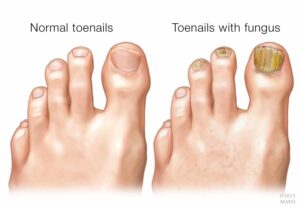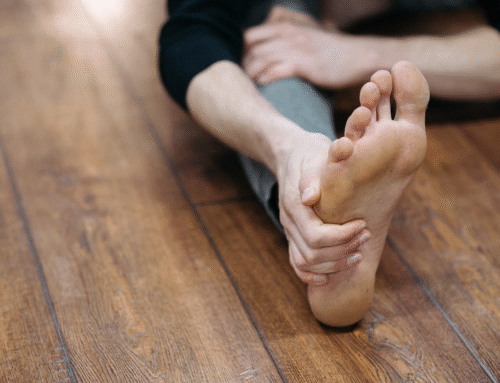Toenail fungus progression can go slowly and spread to all your toenails. Toenail fungus is a common condition that often develops gradually and goes unnoticed at first. It typically affects one or more toenails and thrives in warm, moist environments. Many people don’t recognize the early signs, allowing the infection to worsen over time. Understanding how toenail fungus progresses can help encourage early treatment and prevent long-term complications.
The beginning stages of toenail fungus
Toenail fungus usually begins as a small white or yellow spot near the nail tip. Over time, the infection spreads deeper into the nail bed. The nail may gradually become discolored and start to thicken. In the early stages, many people overlook the mild changes and delay treatment.
As the fungus progresses, the nail can become brittle and start to crumble. It may lift from the nail bed and cause discomfort. In advanced cases, the surrounding skin can appear irritated or inflamed. Without treatment, the infection can spread to other nails and persist for years.
Toenail fungus progression as it spreads
As the condition advances, the nail may take on a distorted shape. Some individuals notice a foul odor from the infected nail. Walking or wearing shoes can become uncomfortable due to pressure on the thickened nail. The infection develops slowly, making it difficult to identify its progression early.
In severe cases, toenail fungus can affect daily activities. People may feel self-conscious about the nail’s appearance. The fungus may spread beyond the toenail if left untreated. Warm and moist environments often make symptoms worse.
Preventing further progression is key to managing the infection. Keeping feet clean and dry helps reduce fungal growth. Wearing breathable socks and shoes limits moisture buildup. Prompt treatment may prevent additional nails from becoming infected.

Types of toenail fungus
There are several types of toenail fungus infections, each affecting the toenail in different ways. Distal lateral subungual onychomycosis is the most common. It usually begins at the toenail tip and spreads underneath. The toenail often becomes thick, discolored, and brittle. White superficial onychomycosis affects the top surface of the toenail. It causes white, chalky spots that may spread if untreated.
Another type is white superficial onychomycosis, which affects only the surface of the toenail. It appears as white, powdery patches that can spread if untreated. The toenail may become soft and flaky. This type responds well to early treatment.
Candida onychomycosis is caused by yeast and can affect both toenails and the surrounding skin. It mainly affects fingernails exposed to frequent moisture. It frequently leads to swelling and redness around the toenail. Toenail discoloration may vary from white to brown. Early identification of the infection type helps determine the best treatment method.
Rare and severe types of toenail fungus
Proximal subungual onychomycosis type is less common and begins at the toenail base near the cuticle. It usually occurs in people with weakened immune systems. The infection slowly moves up the toenail. This type may signal an underlying health issue.
Total dystrophic onychomycosis is the most severe form. It usually develops from a long-term, untreated infection. The entire toenail becomes thick, discolored, and may detach. Toenail damage is often permanent if left untreated.
Treatment with Laser Nail Therapy
The PinPointe FootLaser offers several appealing benefits for individuals struggling with toenail fungus, medically known as onychomycosis, particularly those seeking a noninvasive, drug-free treatment option. One of its primary advantages is that it targets the fungus directly beneath the nail without the need for oral medications, which can sometimes cause liver-related side effects or interact with other prescriptions.
The laser energy penetrates through the nail plate to heat and weaken the fungal cells. This allows the body’s natural processes to promote healthy nail growth. The procedure is quick—typically lasting around 30 minutes per session—and requires no anesthesia or downtime. This allows patients to resume normal activities immediately afterward. For many, this makes it a convenient and safe alternative to long courses of antifungal pills or topical creams that may take months to show visible results.
We offer free consultations
We offer free consultations to see if laser treatment is right for you. At our clinic, laser nail therapy with the PinPointe Footlaser is our specialty. We focus on this treatment because it offers a safe, effective, and medication-free solution for stubborn toenail fungus. We understand how frustrating it can be to deal with thick, discolored nails and how overwhelming it is to sort through different treatment options.
During this consultation, our foot doctors will evaluate your nails, discuss your health history, and determine whether laser treatment is the best choice. During your consultation, we will:
- Examine your nails to confirm the diagnosis and assess severity.
- Explain exactly how the PinPointe FootLaser works and what you can expect during and after treatment.
- Give you a realistic timeline for seeing clearer, healthier nails.
- Answer any questions you have about nail care and preventing reinfection.
Our goal is to help you confidently move forward with a treatment plan that finally addresses your toenail fungus safely and effectively, without the side effects or drug interactions of oral medications.






